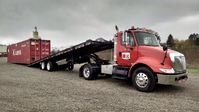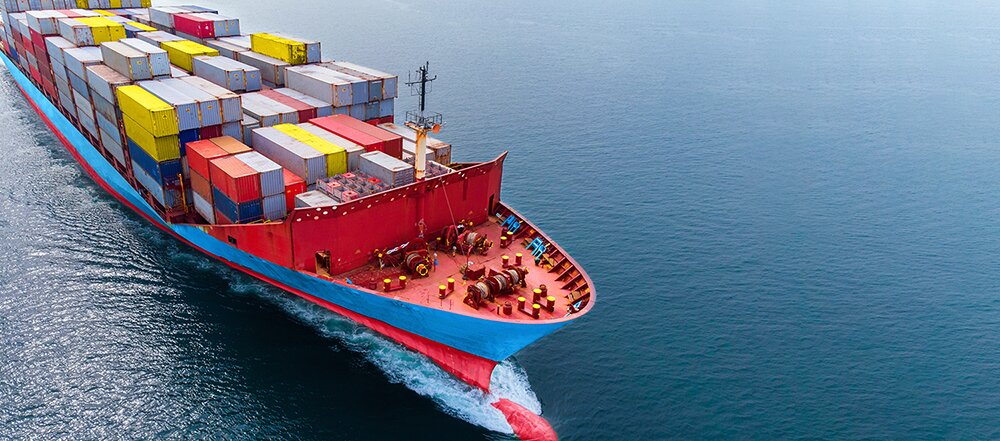Track my order
RESOURCES
What to Expect From Your Shipping Container Delivery
Buying a shipping container? In this guide, we'll go over the most important — and sometimes overlooked — aspects of delivering a shipping container so that you and your delivery driver have the best experience possible.



If you’ve recently bought a shipping container for your business or personal use, you might be wondering what to expect during the delivery process and how to prepare for your container delivery.
In this guide, we'll go over the most important — and sometimes overlooked — aspects of delivering a shipping container so that you and your delivery driver have the best experience possible.
Let's get started!
About the Shipping Container Delivery Process
The Basics of Shipping Container Delivery
Before we get into the specifics, let's cover the basics. A shipping container delivery involves transporting a container from one location to another, whether from a port to a construction site or a depot to your doorstep.
At Boxhub, we have established a network of local carriers who are experts in delivering containers. These carriers are sourced by our first-rate logistics team and have completed hundreds of deliveries to different locations such as rural farms, commercial lots and residential properties. They will deliver your container on a trailer that tilts or rolls back, which means there's no need for special equipment like a forklift or crane to unload them. These trailers are designed to handle the weight and size of the containers, making the unloading process as easy as lifting the trailer so the container can roll off in a controlled way.
What does a shipping container delivery look like?
To get a better understanding of how a shipping container is delivered on a tilt-bed or roll-back trailer, including offloading and container placement, check out this delivery video below.
Setting Expectations
What is the driver responsible for?
Our delivery partners are responsible for:
1. Inspecting the container at the depot: At the depot, the container is loaded onto our trailers with a crane and the driver is responsible for checking them for structural damage and holes. They also test the doors to make sure they open and close and check the inside. If the container doesn’t meet Boxhub's condition guarantee, it’s rejected and another container is loaded.
2. Safe Delivery and Placement: Our delivery partners are trained to handle the specific requirements of shipping container delivery, including the proper loading and unloading procedures. However, the driver has the right to refuse delivery if they don’t feel a drop-site is safe for people or property.
What are you responsible for?
As a Boxhub customer, you are responsible for ensuring your site is safe and accessible for the driver to deliver your container. This includes ensuring that there is sufficient space for the container to be offloaded and positioned correctly (see our delivery checklist below). You may also need to obtain any necessary permits or clearances, depending on the regulations in your area.

Please note
If the driver cannot offload the container at your preferred location, the driver will offload the container at the nearest suitable possible spot. If you do not have a safe and appropriate spot for the container or wish to send it back due to spacing issues, we will refund you the purchase price, minus a 10% re-stocking fee and any fees already incurred.
Preparing for Your Shipping Container Delivery
To be fully prepared, please make sure that you read our delivery checklist:
Step 1: Ensure enough space for maneuvering
Before your delivery driver arrives, verify that the truck will have enough space to maneuver your property. To successfully access and maneuver your property, our carriers require:
- - Clearance width of 14ft (including any gates, fences, or access roads).
- - Clearance height of 16ft.
To unload your shipping container safely, our carriers require:
- - A 120ft line of straight space.
- - Clearance height of 20ft while tilting.
Access roads should be wide enough to accommodate necessary turns into the delivery site and should be clear of low-hanging wires, branches, fences, and other common obstructions. Additionally, the delivery site should have sufficient turning clearance to ensure a smooth roll-off delivery.
Step 2: Ensure the access road is safe
Delivery trucks are heavy — and when loaded with a shipping container, they have an even greater risk of getting stuck if the surface is not firm.
Here’s a list of acceptable and unacceptable terrains:
Acceptable:
- Dry compacted gravel/dirt
- Asphalt
- Concrete
Not Acceptable:
- Loose dirt
- Wet gravel/dirt
- Mud
- Sand
- Soft grass
- Snow and ice
- Steep inclines or sloping surfaces
- Drains
- Ditches
- Trenches
Step 3: Ensure the delivery surface is hard and even
When choosing where your container will be placed, remember that the surface needs to be hard and level for the container to function properly. If the container’s weight is not evenly distributed to all four corner castings, the door frame could bend or be damaged, leading to problems with opening and closing your container.
The ideal surface for placing a shipping container is either concrete or asphalt. We also recommend placing wood blocks, iron plates, or similar under the corners to support them and keep the container level.
If you need help with where to place your container, read our guide on container foundations.
What to Expect on Delivery Day



Check Your Property
Do a final check of the area where the truck will be driving and offloading the container. Make sure it’s free of any obstacles that might damage the truck or prevent the container from being placed. This includes low-hanging tree branches, rocks, debris, and the like.
Meet Your Driver
Your delivery driver will call you in advance to confirm everything is ready for delivery so, it's important that you are available to be contacted on the delivery day.
Once confirmed, the driver will meet you and inspect the delivery location prior to offloading the container. For safety reasons, it is up to the delivery driver to decide whether the site is suitable for the delivery truck.
When the driver has determined the delivery site is safe and accessible, they will proceed to offload your container.
Time Allocated
Our trucking partners impose a 30-minute time cap to offload the container and complete the delivery after arriving at your site. Any additional time taken will be subject to an overtime fee as follows:
- $50 per hour commenced for 20ft containers
- $100 per hour commenced for 40ft and 45ft container
Inspecting Your Shipping Container
Once your container is delivered and in position, take the time to thoroughly inspect it for any visible damage or signs of mishandling during transportation. Check for dents, scratches, or structural issues that might have occurred during the journey.
If you buy a new "one-trip" and used "wind and watertight" container through Boxhub, we guarantee that the containers comply with the following:
- Walls/roofs will not have any holes or leaks ("wind and watertight")
- Doors that open and close properly
- Floors will be intact and functional
Not sure what to look for? Here’s a simple checklist to follow:
- Check Doors: The container doors should be in working condition and able to open and close without using excessive force. If the doors are stiff, we recommend applying oil, grease, or WD40 on the hinges.
- Check for Holes: To inspect for holes, go inside the container (with doors closed but not locked) and look for any light coming in. If any amount of light enters or is visible, this would indicate a small hole. In most cases, this can easily be corrected by applying a small amount of epoxy.
- Check the Floor: Inspect the floors and verify that there are no holes. Keep in mind that it is typical for the floor to have scratches or gouges from forklifts lifting cargo in and out. Should there be any issues, the floor can also be repaired with steel patches or remedies.
Once you have verified that the container is in acceptable condition, confirm with the carrier that you're happy with the container.

Handling Potential Delivery Issues
While every effort is made to have a seamless delivery, unforeseen issues can occasionally arise. If you are unhappy with your container delivery or have any issues with your container, please contact us at +1 888-356-2954 or support@boxhub.com.
In the rare event that the driver concludes it is unsafe to deliver to your desired site, they will deliver to the nearest alternative location. If no alternative delivery location can be agreed upon or you choose to reject the delivery, we will return the container to the depot. In this case, we will refund you the purchase price minus a 10% re-stocking fee and any fees already incurred.

About Hannah Swinkin
Hannah is a B2B marketing leader with a passion for container upcycling projects and cargotecture. She sharpened her marketing expertise at disruptive tech companies transforming antiquated industries, including shipping, parking, and commercial real estate.







Continue Shopping
Loading cart